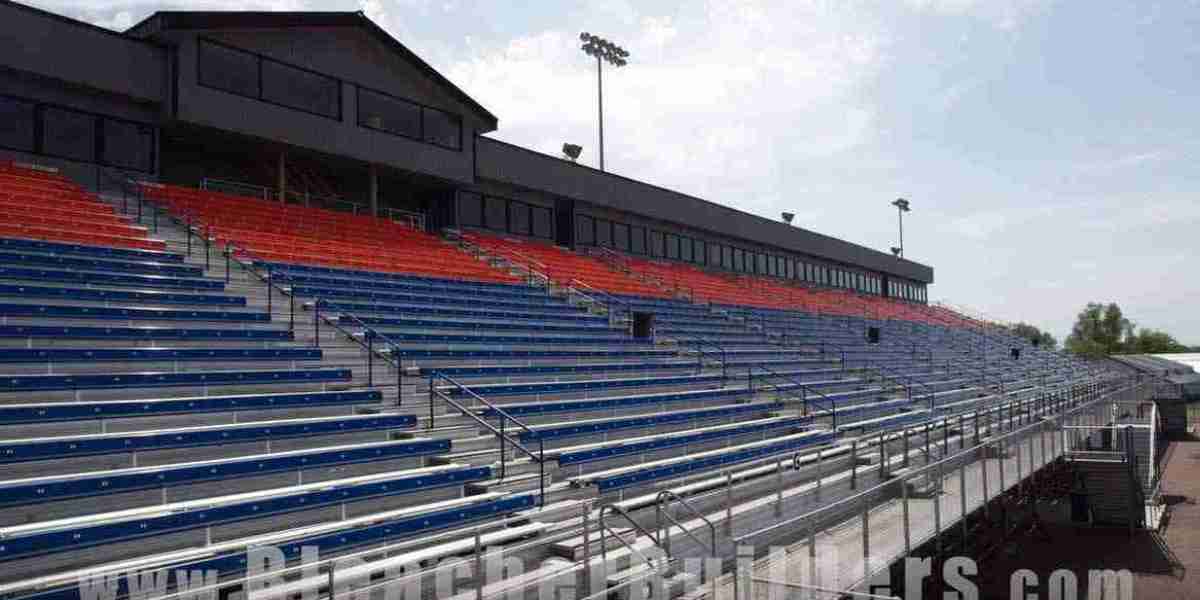When it comes to outfitting a stadium, sports field, or other large venues with seating, bleacher seats are a popular and practical choice. They offer a cost-effective way to provide seating for a large number of people, making them ideal for schools, sports clubs, and community organizations. However, buying used stadium seats for sale involves careful consideration of several factors to ensure you get the best value for your money while meeting your specific needs. This comprehensive buying guide will walk you through everything you need to know about purchasing bleacher seats for sale.
Understanding Bleacher Seats
What Are Bleacher Seats?
Bleacher seats are rows of benches that provide tiered seating in various venues such as sports stadiums, auditoriums, and outdoor event spaces. They are typically made from durable materials like aluminum, steel, or plastic, ensuring they can withstand heavy use and various weather conditions .
Types of Bleacher Seats
- Portable Bleachers : These are designed for flexibility and can be easily moved and reconfigured as needed. They are ideal for schools and sports teams that may need to adjust seating arrangements for different events.
- Permanent Bleachers : Installed as a fixed structure, these are best for venues with a consistent need for seating in the same location. They are more durable and stable than portable options.
- Tip and Roll Bleachers : A hybrid between portable and permanent bleachers, these can be easily tipped and rolled to a new location, providing while maintaining some stability.
- Stadium Bleachers : These are larger and often more complex, designed to accommodate a significant number of spectators. They are usually made of more robust materials to ensure safety and longevity.
Key Considerations When Buying Bleacher Seats
Capacity and Size
The first step in buying bleacher seats for sale is determining the number of spectators you need to accommodate and the space available. Consider the following:
- Audience Size : Estimate the maximum number of people who will be attending events regularly. This will help you decide how many rows and how much seating length you need.
- Space Constraints : Measure the area where the bleachers will be installed. Ensure there's enough room for the bleachers and for spectators to move around comfortably.
Material and durability
Bleacher seats are made from various materials, each with its own benefits and drawbacks:
- Aluminum : Lightweight, rust-resistant, and durable, making it a popular choice for both indoor and outdoor bleachers.
- Steel : Very strong and durable but can be prone to rust if not properly coated or maintained.
- Plastic : Lightweight and available in various colors, but may not be as durable as metal options.
- Wood : Traditional and aesthetic but requires more maintenance and is less durable in outdoor settings.
Safety Features
Safety is paramount when it comes to bleacher seating. Look for the following features:
- Guardrails : Essential for preventing falls from higher rows.
- Non-Slip Surfaces : Ensure steps and seats have non-slip surfaces to prevent accidents.
- Adequate Aisles : There should be enough space for people to move in and out of their seats easily.
- Anchoring Systems : Permanent bleachers should have a solid anchoring system to keep them securely in place.
Comfort and Accessibility
- Seat Design : While some bleachers feature simple bench seating, others may have backrests for added comfort.
- Seat Width and Legroom : Ensure there's enough space for spectators to sit comfortably without feeling cramped.
- Accessibility : Make sure the bleachers are accessible to individuals with disabilities, including wheelchair access and designated seating areas.
Maintenance and Warranty
Consider the long-term maintenance needs and warranty offered by the manufacturer:
- Maintenance Requirements : Some materials require more maintenance than others. For example, wood needs regular sealing, while aluminum is low maintenance.
- Warranty : Check the warranty details to understand what is covered and for how long. A good warranty can provide peace of mind and protect your investment.
Finding Bleacher Seats for Sale
New vs. Used Bleacher Seats
You have the option to buy new or used bleacher seats, each with its pros and cons:
- New Bleacher Seats : Offer the latest designs, materials, and safety features. They come with a manufacturer's warranty and are typically in pristine condition.
- Used Bleacher Seats : More cost-effective and can be just as durable if they have been well-maintained. However, they may lack the latest features and could have some wear and tear.
Where to Buy Bleacher Seats
- Specialty Retailers : Companies that specialize in sports equipment and stadium seating often offer a wide selection of bleacher seats.
- Online Marketplaces : Websites like eBay and Craigslist can be good sources for used bleacher seats, but exercise caution and verify the seller's credibility.
- Direct from Manufacturers : Buying directly from the manufacturer can sometimes get you a better deal and more customization options.
- Surplus Sales : Schools, sports clubs, and municipalities sometimes sell their surplus bleacher seats, which can be a great way to find used seats at a good price.
Evaluating Sellers
When choosing a seller, consider the following:
- Reputation : Look for reviews and testimonials from previous customers.
- Experience : Sellers with years of experience are more likely to provide reliable products and services.
- Customer Service : Good customer service is essential, especially if you have questions or issues after the purchase.
Installation and Setup
DIY vs. Professional Installation
- DIY Installation : If you have the skills and tools, installing bleacher seats yourself can save money. However, it requires careful planning and adherence to safety standards.
- Professional Installation : Hiring professionals ensures the bleachers used for sale are installed correctly and safely. It's often worth the extra cost for peace of mind and compliance with regulations.
Installation Tips
- Preparation : Clear the area where the bleachers will be installed and ensure the ground is level.
- Following Instructions : Carefully follow the manufacturer's instructions for assembly and installation.
- Safety Checks : After installation, conduct a thorough safety check to ensure everything is secure and stable.
Maintenance Tips for Longevity
To keep your bleacher seats in good condition and extend their lifespan, follow these maintenance tips:
- Regular Cleaning : Remove debris and clean the seats regularly to prevent buildup of dirt and grime.
- Inspect for Damage : Regularly inspect the bleachers for signs of wear and tear, such as rust, loose bolts, or cracked seats.
- Protective Coating : Apply protective coatings to metal parts to prevent rust and corrosion.
- Repair Promptly : Address any damage or maintenance issues promptly to prevent them from worsening.
Conclusion
Purchasing bleacher seats is a significant investment that requires careful consideration of various factors, including capacity, material, safety, comfort, and maintenance. Whether you're buying new or used bleacher seats, it's essential to evaluate your thoroughly options and choose a reputable seller By following the guidelines in this comprehensive buying guide, you can ensure that you select the best bleacher seats for your venue, providing safe and comfortable seating for all spectators.
Remember, the key to a successful purchase is thorough research and planning. Take the time to assess your needs, compare different options, and make an informed decision that balances cost, quality, and functionality. With the right bleacher seats, you can enhance the spectator experience and create a welcoming environment for all attendees



